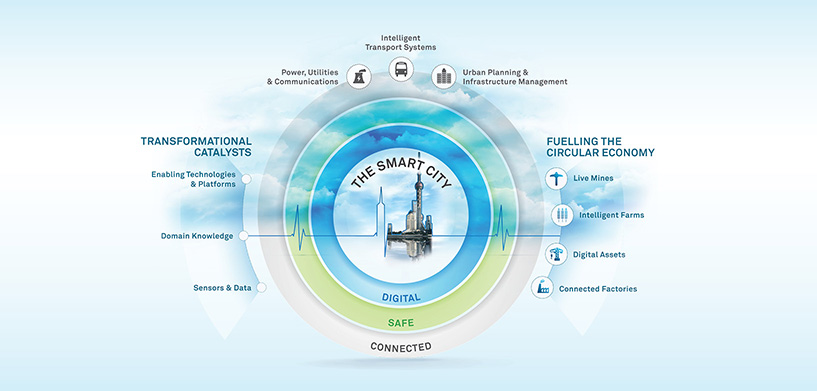I’ve had the privilege of living in or visiting many of the great cities of the world. Each one has its own character, its own personality. I think it’s fair to say that our cities shape us. A Parisian is not like a Muscovite, who is not like a Stockholmer, who is not like a New Yorker.
But as much as our cities shape us, it’s important that we shape our cities, too – into Smart Cities.
The urgency for smart cities is real. Over 50% of the world’s population now lives in urban areas, and this number is expected to climb to 70% by 2050.
Yet, all the data, technologies and solutions that promise to revolutionise urban life, have limited value when used individually. The power behind a smart city lies in how well the pieces are connected and function together. That’s what enables cities to truly become “smart”, and ultimately, improve people’s lives.
It’s why Hexagon is putting its portfolio to work across three areas essential to every smart city —
Digital, Safe and Connected.
Cities are living, breathing, dynamic and extraordinarily complex organisms. To move them beyond today’s capabilities is almost impossible without a fully immersive, contextual, digital experience to work with – the Smart Digital Reality.
What do I mean by “smart digital reality”? Let’s look at an example…
Imagine yourself physically being in Hong Kong, yet able to move through New York City – roaming its streets, entering its buildings, wandering through its underground tunnel systems – without any limits to where you can go.
Now imagine intelligently linking this 3D world with the element of time; that is, what’s happening now. When you turn a 3D experience into 4D, it’s much more than a digital twin – because it’s anything but static. It’s “alive” and full of life, sharing its constantly-changing landscape with you – from traffic flows, lightning strikes and air quality, to any other event that is unfolding. There’s no limit to the types or number of changing conditions you can experience.
But the real value of a digital-first city doesn’t stop there. Imagine having access to any information (not just real-time), adding even more context and essentially turning your 4D experience into a 5D reality. From documents and databases to history and statistics – whatever it is you want or need to know is right at your fingertips.
Smart cities are digital first because smart digital realities set the stage for “all things possible” – first and foremost, the possibility of real safety.
There’s no such thing as an unsafe utopia, which is why the safety of a city’s residents, workers and visitors is critical to making the transition to a smart city.
But ensuring safety has never been more complicated and unpredictable – whether preparing for concerts, natural disasters, industrial accidents, environmental emergencies, power outages, cyber-attacks or terrorism. Efforts to increase comfort, convenience and openness – all good things – have the unintended consequence of making cities more vulnerable to public safety challenges and threats.
Our single greatest defense is utilising data and technology as a “force multiplier”, so public safety officials and first responders can do their greatest work – from augmenting capabilities with autonomous eyes and ears, to unifying multi-agency planning and response, and ensuring every citizen’s voice is heard.
Ultimately, cities must contend with sharing information and coordinating activities within and across organizations and jurisdictions. Because when it comes to ensuring the safety of our world’s cities, it is not a matter of “when” the unavoidable might happen, but rather how we will respond when it does.
A city that isn’t absolutely connected will never be a well-oiled machine.
Most people immediately think of acronyms like IoT when I mention the connected requirements of a smart city. But an absolutely connected city is so much more than that.
It’s the ability to digitalise any process and “see” (in real time) all of the millions of events and changes occurring every day. It’s the ability to connect everything in the city’s ecosystem, so that all available and changing data can be used to interpret, report and predict. It’s the ability to integrate the intelligence and visualisation capabilities necessary for decision-making at speeds greater than human capacity.
At the end of the day, the shape of a smart city all comes down to data— and how we enable and empower that data to do its greatest good. With the right data, nearly any challenge can be overcome.
At Hexagon, we’re digitally transforming urban landscapes, bringing simplicity to synchronicity so that cities can create the autonomous system of systems necessary to reach smart city potential – digital, safe, connected, efficient, clean, and thriving.
As the world continues to urbanize, cities will continue to shape their citizens. And I’m optimistic and excited to see how, together, we can shape smart cities.
Hexagon. Shaping Smart Cities. Shaping Smart Change.

















